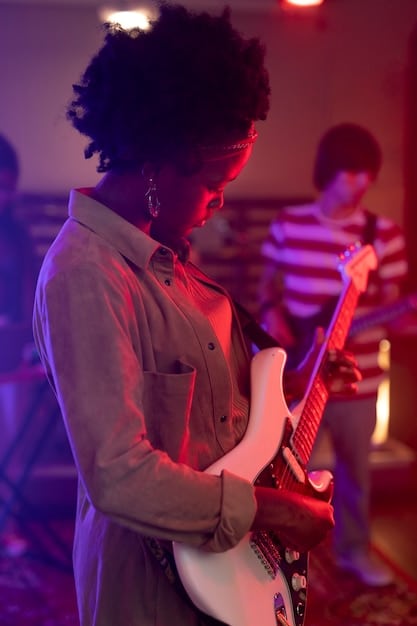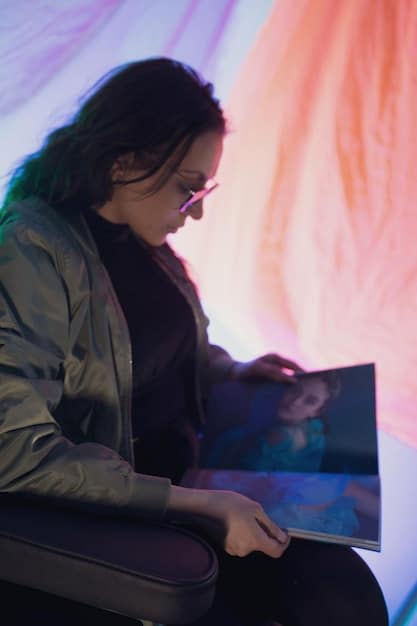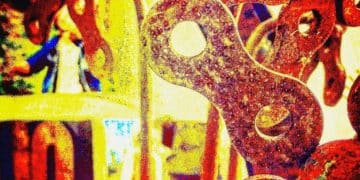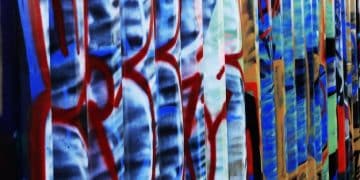Can NFTs Increase Underground Music Revenue by 15% This Year?

Exploring the potential for non-fungible tokens, or NFTs, to significantly increase revenue for underground musicians by up to 15% this year involves a critical look at current adoption rates, fan engagement models, and market viability within the independent music scene.
The landscape of the music industry is in constant flux, with new technologies frequently emerging to challenge traditional models. In this dynamic environment, the question of whether NFTs for underground musicians can generate a 15% increase in revenue this year has become a focal point of discussion. This article delves into the potential of NFTs as a transformative tool for independent artists, exploring both their promise and practical implications.
Understanding NFTs: More Than Just Digital Art
Non-fungible tokens, or NFTs, have captivated public attention primarily through their association with digital art and collectibles. However, their utility extends far beyond static images. At their core, NFTs are unique digital assets stored on a blockchain, verifying ownership and authenticity. This foundational characteristic presents a myriad of possibilities for creators, especially those in the music sector often overlooked by mainstream channels.
The Core Technology: Blockchain’s Role
The underlying technology for NFTs is the blockchain, a distributed, immutable ledger. Each NFT contains unique identifying information recorded on this chain, making it impossible to replicate or tamper with. This transparency and immutability are crucial for establishing trust and verifying scarcity in the digital realm. For musicians, this means a reliable way to prove ownership of their work and its associated rights, opening new avenues for monetization and fan engagement.
- Decentralization: Removes intermediaries, allowing direct artist-to-fan interactions.
- Provenance: Provides an undeniable record of ownership and transaction history.
- Programmability: Enables smart contracts for automated royalty distribution and future earnings.
Beyond the Hype: Practical Applications for Musicians
While the initial frenzy around eye-popping NFT sales figures might overshadow their practical applications, it’s essential for underground musicians to look beyond the speculative bubble. NFTs can represent unique songs, album artwork, concert tickets, backstage passes, or even fractions of a song’s publishing rights. This versatility transforms how artists can sell their work, engage their audience, and build sustainable careers outside traditional record labels.
The real value proposition lies in creating scarcity and unique experiences for fans. Instead of simply buying a digital download, a fan holding an NFT gains a verifiable piece of an artist’s catalog or a special access pass directly tied to their creative output. This fosters a deeper connection and sense of ownership, which can translate into significant financial support.
Current Landscape for Underground Musicians
The traditional music industry has long presented significant barriers for underground musicians. Issues such as low streaming royalties, limited direct fan engagement opportunities, and the struggle for adequate compensation remain pervasive. These challenges underscore the urgent need for alternative revenue streams and more equitable distribution models.
Challenges of Traditional Revenue Streams
For independent artists, relying solely on streaming platforms often leads to meager earnings. While global reach is undeniable, the fractions of a cent earned per stream rarely sustain a career. Live performances, once a primary income source, have faced disruptions, leaving many artists searching for stability. Merch sales and direct album purchases help, but their scalability is often limited to a niche audience.

The challenge extends beyond direct financial returns. Building and maintaining a dedicated fanbase in a saturated market requires considerable effort, often with little return on investment in the early stages. This often forces artists to compromise their artistic vision to fit commercial trends, hindering the authentic expression that defines underground music.
The Shift Towards Direct-to-Fan Models
The internet has already paved the way for direct-to-fan sales and crowdfunding, but NFTs take this concept a step further. Platforms like Bandcamp have shown that fans are willing to directly support artists they love. NFTs can amplify this effect by offering unique, verifiable digital collectibles that serve as both a financial asset and a symbol of fan allegiance. This creates a more robust ecosystem where loyalty is rewarded and value is exchanged directly.
Artists can now bypass traditional gatekeepers and create their own economies, setting their own prices and terms for their digital assets. This autonomy is particularly appealing to underground musicians who value independence and artistic control. The ability to directly connect with and monetize a core fanbase is a powerful motivator for exploring NFT technology.
How NFTs Can Boost Revenue
The potential for NFTs to significantly impact the revenue of underground musicians stems from several distinct mechanisms. These include direct sales of unique digital assets, royalty distributions, innovative fan engagement, and new forms of intellectual property monetization. Each of these avenues presents a compelling case for a revenue increase, potentially reaching the targeted 15% mark or even exceeding it.
Direct Sales and Collectibles
The most straightforward way NFTs generate income is through direct sales. Musicians can mint limited editions of songs, unreleased demos, album art, or even unique visualizers tied to their music. These digital collectibles can be sold at a premium, instantly providing artists with upfront capital. Unlike streaming, where revenue trickles in over time, an NFT sale offers immediate and often substantial income.
- Limited Edition Tracks: Selling unique versions or stems of a song.
- Digital Album Art: Monetizing the visual components of their releases.
- Concert Memorabilia: Offering exclusive digital tickets or behind-the-scenes content as NFTs.
The perceived scarcity of these digital items often drives demand and value, much like physical vinyl records or limited edition merchandise. Fans aren’t just buying music; they’re investing in a unique piece of an artist’s creative journey, directly contributing to their livelihood.
Royalty Mechanisms and Secondary Markets
One of the most revolutionary aspects of NFTs is the ability to program royalties into their smart contracts. This means that every time an NFT is resold on a secondary market, the original artist can receive a predetermined percentage of the sale price. This passive income stream is virtually non-existent in traditional music sales, where artists typically don’t profit from resales of physical records or used digital files.
This royalty mechanism transforms an artist’s work into a long-term asset, providing continuous income as their popularity grows and their NFTs appreciate in value. For underground musicians, this could be a game-changer, offering a sustainable financial model that rewards their creative output indefinitely. It also incentivizes early fans to invest, as their support could yield returns if the artist gains wider recognition.
Fan Engagement and Community Building
Beyond direct financial transactions, NFTs offer an unparalleled opportunity for underground musicians to foster deeper fan engagement and cultivate thriving communities. This shift from passive consumption to active participation can be a powerful driver of both loyalty and long-term revenue, far exceeding the transactional nature of traditional music consumption.
Exclusive Access and Experiences
NFTs can serve as digital keys unlocking exclusive content and experiences for dedicated fans. This might include access to private Discord channels, early releases of new music, invitations to online Q&A sessions, or even physical meet-and-greets. By offering tiered NFT ownership, artists can create different levels of exclusivity, rewarding their most loyal supporters with unique benefits.
This model moves beyond a simple creator-consumer relationship, transforming fans into active participants in an artist’s journey. Such unique access builds significant goodwill and strengthens the emotional bond between the artist and their audience, encouraging continued support through future NFT drops and other ventures. Consider the potential for exclusive live streams or virtual concerts accessible only to NFT holders.
Building a Decentralized Fanbase
NFTs can help artists cultivate a truly decentralized and engaged fanbase. By owning a piece of an artist’s work, fans become stakeholders, often feeling a greater sense of pride and connection. This communal aspect can lead to organic promotion, as loyal fans become evangelists, sharing the artist’s work and spreading awareness within their networks.
Moreover, the structure of certain NFT platforms allows for direct communication channels with holders, enabling artists to create a direct dialogue with their most dedicated supporters. This immediate feedback loop can inform future creative decisions, making fans feel heard and valued. This bottom-up community building approach bypasses the centralized control of traditional social media platforms, giving artists more direct control over their narrative and engagement strategies.
The ability to create gated communities around NFT ownership allows artists to identify and nurture their super-fans, who are often the most willing to invest financially and emotionally in their art. This targeted approach is far more effective than broadcasting to a general audience, leading to higher conversion rates for future releases or special projects.
Challenges and Considerations
While the promise of NFTs for underground musicians is compelling, several challenges and considerations need to be addressed. Navigating these obstacles is crucial for artists hoping to leverage this technology for a sustainable revenue increase, especially aiming for a significant jump like 15% within a year.
Market Volatility and Speculation
The NFT market, particularly in its nascent stages, is notoriously volatile. Prices can fluctuate wildly based on hype, market sentiment, and broader cryptocurrency trends. This speculative nature means that while some artists might see significant windfalls, others could struggle to find buyers or experience drastic drops in value for their minted NFTs. Underground musicians, often with limited resources, must approach this with caution.
Artists should avoid the temptation of creating NFTs solely for speculative purposes. Instead, focus should be on providing intrinsic value to the buyer, whether through exclusive content, artistic merit, or a strong community proposition. Sustainable growth will come from building a loyal collector base, not from chasing fleeting trends.
Technical Barriers and Accessibility
Minting, selling, and managing NFTs still involve a learning curve. Understanding blockchain wallets, gas fees, and marketplace mechanics can be daunting for artists whose primary focus is typically on music creation. While platforms are becoming more user-friendly, a certain level of technical literacy is still required.

Furthermore, accessibility for fans can be another hurdle. Many potential buyers may not have cryptocurrency wallets or understand how to purchase NFTs, limiting the potential audience. Simplifying the purchasing process and providing clear guidance for fans will be essential for widespread adoption and, consequently, revenue growth.
Environmental Concerns and Sustainability
The environmental impact of certain blockchain technologies, particularly proof-of-work protocols like those used by Ethereum (though rapidly transitioning to proof-of-stake), has been a significant concern. The energy consumption associated with minting and transacting NFTs can deter environmentally conscious artists and fans.
However, the sector is rapidly evolving. Many newer blockchain networks and Layer 2 solutions are designed to be significantly more energy-efficient. Artists interested in NFTs should research and choose platforms that align with their sustainability values, using eco-friendly blockchains to mitigate these concerns and appeal to a broader audience that prioritizes environmental responsibility.
Addressing these challenges requires a strategic approach. Artists need to educate themselves, choose platforms wisely, and communicate transparently with their fanbase about the technology and its benefits. It’s not just about creating an NFT; it’s about building a sustainable ecosystem around it.
Case Studies and Success Stories
While the NFT space is relatively new, several early adopters, including underground and independent artists, have demonstrated its potential for revenue generation and community building. Examining these success stories offers valuable insights and practical lessons for aspiring musicians looking to explore this frontier.
Independent Artists Breaking Through
Artists like 3LAU, a DJ and producer, pioneered the use of music NFTs, generating millions from his “Ultraviolet” album tokenized as NFTs. While 3LAU operates at a higher tier, his success highlights the direct correlation between unique digital assets and substantial fan value. Smaller, independent artists have also found success by offering unique audio clips, stems, or even the rights to remix their tracks.
For example, a lesser-known indie band might release 10 exclusive NFTs of their unreleased demo, each granting the owner a lifetime pass to their online concerts. These types of offerings create a sense of direct ownership and engagement that goes far beyond traditional album sales or streaming royalties. The key is in the exclusivity and the community benefits tied to the NFT.
Platforms Facilitating Growth
Several platforms have emerged to facilitate the creation and sale of music NFTs, making the process more accessible for underground artists. Sound.xyz, Catalog, and Royal are examples of marketplaces focusing specifically on music, often offering curated experiences and direct tools for artists to mint and sell their work directly to fans.
These platforms often provide analytics and community features, helping artists understand their audience and engage effectively. The ease of use on these specialized platforms lowers the technical barrier, allowing musicians to focus more on their creative output and less on blockchain mechanics.
Another notable success involves artists using NFTs to fund their next album or tour. By selling “album rights” or “tour passes” as NFTs, musicians can raise significant capital directly from their fanbase, bypassing traditional crowdfunding and giving fans verifiable ownership of a piece of their project. This model not only funds projects but also builds a highly invested community around the artist’s future endeavors.
The 15% Revenue Increase: Is It Realistic?
The initial query was whether NFTs could generate a 15% increase in revenue for underground musicians within a year. Based on the current trajectory and the unique advantages NFTs offer, this goal is certainly ambitious but not beyond the realm of possibility for artists who approach it strategically.
Factors for Achieving the Goal
Achieving a 15% revenue increase through NFTs hinges on several critical factors. Firstly, the artist must have an existing, albeit niche, fanbase willing to engage with new technologies. Converting even a small percentage of loyal fans into NFT collectors can provide a substantial boost. Secondly, the artist needs to offer compelling and valuable NFTs that resonate with their audience, whether it’s unique music, exclusive experiences, or a strong community proposition.
Marketing and education also play a vital role. Artists must effectively communicate the value proposition of their NFTs to their audience, explaining the benefits and simplifying the purchasing process. Partnerships with NFT-savvy individuals or platforms can also accelerate adoption. Finally, consistency in releasing new NFT drops and engaging with the community is key to building sustainable momentum.
A Strategic Approach for Underground Artists
For underground musicians, a gradual and experimental approach might be most effective. Start with a small, limited drop of a unique song or piece of artwork. Learn from the initial reception, gather feedback, and iterate. This allows artists to understand their market without significant financial risk. Focusing on utility and community building, rather than just speculative value, will foster long-term loyalty.
The 15% target isn’t a guaranteed outcome but a potential ceiling for strategically deployed NFT initiatives. It requires active participation from the artist, a keen understanding of their audience, and a willingness to embrace new digital business models. For many, even a 5-10% increase could be transformative, providing much-needed financial stability and artistic freedom. The future of independent music undoubtedly includes blockchain technology, and NFTs are at the forefront of this evolution.
| Key Point | Brief Description |
|---|---|
| 🎶 Direct Sales | Musicians can sell unique digital assets like songs or art directly to fans. |
| 💰 Royalty Mechanisms | Artists earn passive income from secondary market NFT resales via smart contracts. |
| 🤝 Fan Engagement | NFTs unlock exclusive content, access, and stronger community bonds. |
| 📈 Realistic Goal | 15% revenue increase is ambitious but achievable with strategic implementation and fan base engagement. |
Frequently Asked Questions About NFTs for Musicians
▼
A music NFT is a unique digital token representing ownership of a piece of music, album art, or related digital content. It’s stored on a blockchain, verifying its authenticity and providing artists with a new way to monetize their creations and engage directly with fans.
▼
When you mint an NFT, you can embed a royalty clause into its smart contract. This means that every time your NFT is resold on a secondary marketplace, a predefined percentage of the sale price is automatically sent back to your wallet. This provides a continuous income stream.
▼
While basic technical understanding is helpful, many platforms like Sound.xyz or Catalog simplify the process of minting and selling music NFTs. They offer user-friendly interfaces that guide artists through the steps, reducing the need for deep blockchain expertise.
▼
NFTs offer direct monetization, bypassing intermediaries, and enable artists to earn royalties from resales. They foster deeper fan engagement by providing exclusive content and community access, building strong, loyal fanbases and offering new ways to fund projects directly.
▼
Some blockchain networks, particularly those using older “proof-of-work” systems, can be energy-intensive. However, many newer platforms and blockchains are designed to be significantly more eco-friendly (“proof-of-stake” or other low-power alternatives), reducing the environmental impact of NFT creation and transactions.
Conclusion
The potential for NFTs to significantly increase artist revenue, particularly the ambitious 15% target for underground musicians within a year, is a testament to the transformative power of decentralized technology. While challenges exist in market volatility and technical adoption, the opportunities for direct monetization, innovative royalty streams, and unparalleled fan engagement present a compelling case. Artists who embrace this emerging ecosystem with a strategic, community-focused approach are best positioned to leverage NFTs not just as a financial tool, but as a catalyst for creative autonomy and sustainable careers in a rapidly evolving music landscape.





